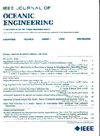Beam Converging and Slope Search Processing by Striation-Correlation-Based Beamforming in Shallow Water
IF 5.3
2区 工程技术
Q1 ENGINEERING, CIVIL
引用次数: 0
Abstract
In this article, we investigate the feasibility of using striation-based beamforming (SBF) methods to address the performance degradation of conventional beamforming (CBF). The research results demonstrate that the process of SBF utilizing interference striations along the horizontal array can exploit phase coherence among signals to achieve beam converging–allowing to form the same directivity for different modes, which can thereby help restore beam resolution and ensure array gain. Furthermore, this paper expands the striation-correlation-based beamforming (SCBF) to utilize array data generated from the cross-correlation of CBF beam output (BO) and array pressure signals (named as SCBF-BO). This SCBF-BO method can eliminate source spectrum and truncation time limitations inherent in SBF applications while maintaining the beam converging capability. Finally, the SCBF-BO algorithm for search of different slope values is proposed. The main-lobe position of SCBF-BO's BO is approximately independent of the striation slope used, but processing along the optimal slope maximizes the convergence gain of SCBF-BO. The slope search of SCBF-BO overcomes the dependence of SBF methods on previously obtaining slope information from the external acoustic intensity image processing. Moreover, the coherent processing of both amplitude and phase enables the slope search of SCBF-BO to achieve the optimal BO performance quickly when the signal-to-noise ratio of the selected BO exceeds 0 dB. Simulation results under Pekeris waveguide and summer thermocline conditions, as well as the synthetic aperture of approximately 959 m horizontal array in the northern Yellow Sea experiment conducted in winter 2011, are provided as illustrations.浅水中基于条纹相关波束形成的波束收敛和斜率搜索处理
在本文中,我们研究了使用基于条纹的波束形成(SBF)方法来解决传统波束形成(CBF)性能下降的可行性。研究结果表明,沿水平阵列方向利用干涉条纹的SBF过程可以利用信号之间的相位相干性实现波束收敛,使不同模式下形成相同的指向性,从而有助于恢复波束分辨率,保证阵列增益。进一步扩展了基于条纹相关的波束形成(SCBF),利用CBF波束输出(BO)与阵列压力信号(SCBF -BO)相互关联产生的阵列数据。该方法在保持波束收敛能力的同时,消除了SBF应用固有的源频谱和截断时间限制。最后,提出了搜索不同斜率值的SCBF-BO算法。SCBF-BO的主瓣位置与所用的条纹斜率近似无关,但沿最优斜率处理可使SCBF-BO的收敛增益最大化。SBF - bo的坡度搜索克服了以往SBF方法依赖于从外声强图像处理中获取坡度信息的缺点。此外,通过对幅值和相位的相干处理,使得SCBF-BO的斜率搜索能够在所选BO的信噪比超过0 dB时快速实现最佳BO性能。给出了Pekeris波导和夏季温跃层条件下的模拟结果,以及2011年冬季在黄海北部进行的约959 m水平阵列合成孔径实验。
本文章由计算机程序翻译,如有差异,请以英文原文为准。
求助全文
约1分钟内获得全文
求助全文
来源期刊

IEEE Journal of Oceanic Engineering
工程技术-工程:大洋
CiteScore
9.60
自引率
12.20%
发文量
86
审稿时长
12 months
期刊介绍:
The IEEE Journal of Oceanic Engineering (ISSN 0364-9059) is the online-only quarterly publication of the IEEE Oceanic Engineering Society (IEEE OES). The scope of the Journal is the field of interest of the IEEE OES, which encompasses all aspects of science, engineering, and technology that address research, development, and operations pertaining to all bodies of water. This includes the creation of new capabilities and technologies from concept design through prototypes, testing, and operational systems to sense, explore, understand, develop, use, and responsibly manage natural resources.
 求助内容:
求助内容: 应助结果提醒方式:
应助结果提醒方式:


